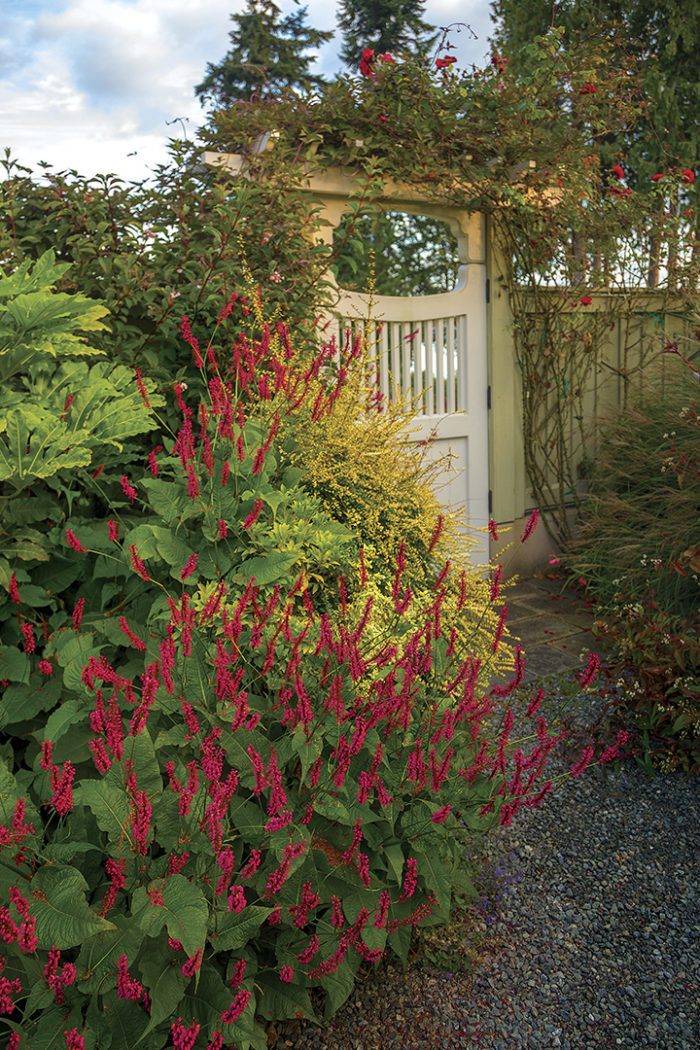
Many people like to have a garden for entertaining, but most of us also want our gardens to be a spot where we relax and get away from it all. My client with the large courtyard was no different. She wanted several things from her space, but at the top of the list was that it be an intimate, private refuge. Though the area was a blank slate in the middle of construction, I knew that I could give her the space that she wanted if I created a sense of enclosure, kept things in scale, and added an atmosphere of seclusion.
Start with a sense of enclosure
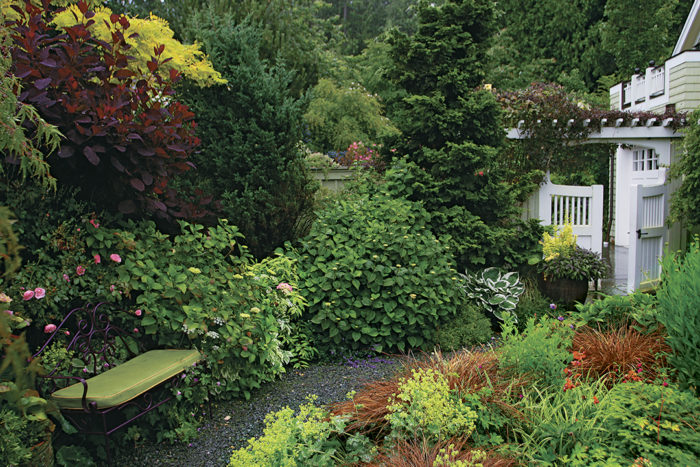
To feel cozy or relaxed in a space, one must feel embraced by it, as though it encircles you in solitude and safety. The first step in creating this atmosphere is to provide a sense of enclosure. The construction of a fence around my client’s courtyard provided a physical enclosure but did nothing to create the feeling of intimacy that she desired. To achieve a softer, more private space, we added 10- to 20-foot-tall evergreen trees, such as compact Hinoki cypress (Chamaecyparis obtusa ‘Compacta’, USDA Hardiness Zones 4–8), and several types of deciduous trees, including large cultivars of Japanese maples (Acer palmatum cvs., Zones 5–8). While not obscuring the fence, these trees soften it, acting like an informal hedge. They also provide a canopy or ceiling to the area, which adds to the aura of privacy and intimacy.
I complemented these trees with shrubs, perennials, ornamental grasses, and ground covers in many sizes and with varying leaf textures, colors, and shapes. We included evergreen ‘Densiformis’ spreading yew (Taxus media ‘Densiformis’, Zones 5–7); deciduous ‘Grace’ smoke bush (Cotinus ‘Grace’, Zones 5–9); and perennials, such as hardy geranium (Geranium spp. and cvs., Zones 4–8) and lady’s mantle (Alchemilla mollis, Zones 4–7).

The sheer number, variety, and lushness of the plantings add to the feeling of privacy. Additionally, the floor of the garden slopes down in some areas, creating elevation changes that surround you with foliage, truly making you feel embraced by the garden.
Keep things comfortable by staying in scale
No space can make a person feel private and secure if the scale is not correct. If a place does not have elements that relate to a person by virtue of their size (they are either too big or too small), that person cannot connect with the space.
Throughout my client’s courtyard, I made sure to keep things in harmony with human scale. The canopy provided by the trees serves as a roof and keeps the garden from feeling like an endless universe. Balancing those tall trees with the shrubs, perennials, and ground covers brings the plantings down to a level where a person can better experience them. Textures beg to be touched, colors can be viewed up close, and fragrance can’t be missed.
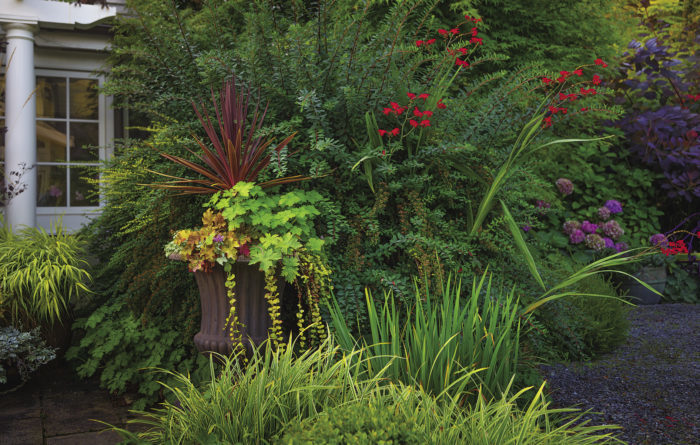
Elevation changes created the opportunity to add a low sitting wall, and the large water feature was brought into scale by also providing visitors a place to sit. This allows a person in the garden to be able to interact with the hardscaping and feel as if they are part of the space.
I kept the size of the seating areas small to stay in scale and to maintain the cozy atmosphere. The same holds true for the paths: They are just wide enough for folks to stroll two abreast and share the experience together. If a path is too wide, visitors lose intimacy with the plants in the garden.
No matter what the size of the area, if you are trying to create a warm, cozy, contemplative atmosphere, then you must create a sense of separation.
Plants and paths create separation
No matter what the size of the area, if you are trying to create a warm, cozy, contemplative atmosphere, then you must create a sense of separation. Even in my client’s large courtyard (almost a quarter acre), I accomplished this. The central water feature draws people into the garden. From there, four paths diverge, adding a sense of mystery and beckoning visitors to explore.
Along the paths, I created several seating areas, to be used not only for personal time but also for social gatherings. These seating areas are surrounded by plants, and when one is in one spot, the other areas cannot be seen.
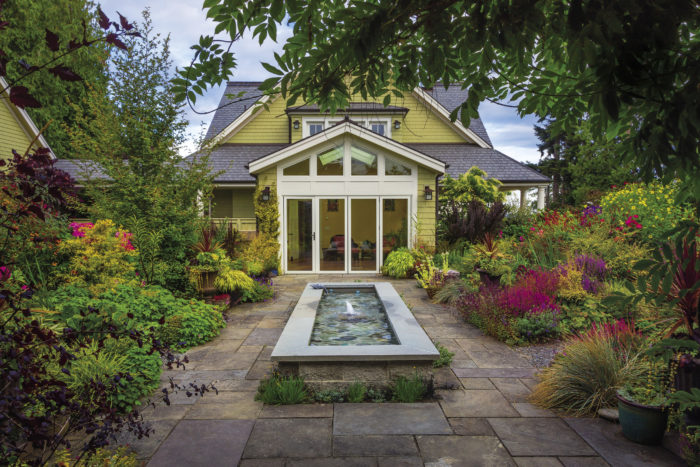
The plants along the paths also help create privacy. Medium-size evergreen and deciduous trees and shrubs, for example, screen one area from another. I make sure, however, to use see-through plants, such as fleeceflower (Persicaria spp. and cvs., Zones 3–9) and tall verbena (Verbena bonariensis, Zones 7–11), to create a veil so that the feeling of seclusion never veers into claustrophobia. These and other similar plant groupings are dreamy and translucent—not solid or hedgelike—giving the home owner glimpses ahead, leading to a sense that there is always something unexpected just around the corner. If you have a garden where room is limited, all this can be done on a smaller scale or with fewer paths and destinations.
My client’s courtyard is the intimate, contemplative spot that she always wanted—all because of the proper use of enclosure, scale, and separation.
Three Ways to Create Intimacy
An intimate space doesn’t have as much to do with size as it does with atmosphere. Employing the following three design elements will help you create the quiet oasis you desire.

Stacie Crooks is a Seattle-based garden designer and educator who has created gardens and containers of every style and size throughout the Pacific Northwest.
Photos, except where noted: David Perry. Illustration: Elara Tanguy
Fine Gardening Recommended Products

The Nature of Oaks: The Rich Ecology of Our Most Essential Native Trees
Fine Gardening receives a commission for items purchased through links on this site, including Amazon Associates and other affiliate advertising programs.

ARS Telescoping Long Reach Pruner
Fine Gardening receives a commission for items purchased through links on this site, including Amazon Associates and other affiliate advertising programs.

A.M. Leonard Deluxe Soil Knife & Leather Sheath Combo
Fine Gardening receives a commission for items purchased through links on this site, including Amazon Associates and other affiliate advertising programs.


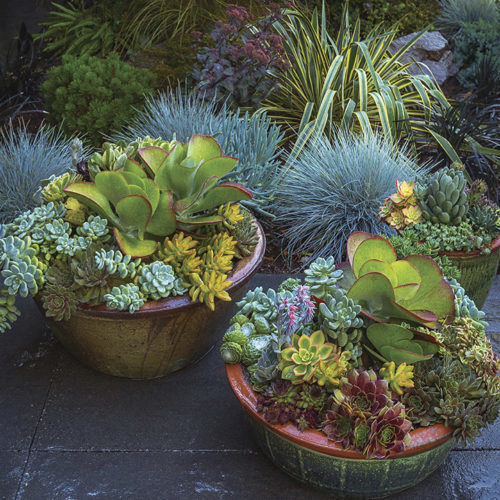
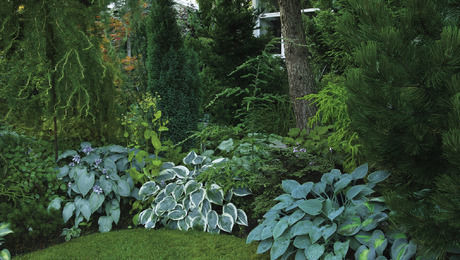














Comments
Log in or create an account to post a comment.
Sign up Log in